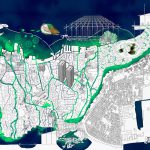This group exhibition at Lisson Gallery brings together works by artists who present mutable forms of matter – whether embodied in clay, rock, pigment, plastic, metal or organic substances – as active agents in the complex entanglements of humans and the more-than-human world. Moving beyond the idea of nature as raw material abundantly available for humans to use, this exhibition acknowledges the distinct properties, agencies and histories of materials, taking heed of their dynamic role in sustaining dense, interwoven relations.
These artists come from many parts of the world and critically engage with the materials associated with their respective cultural inheritances. Their work speaks to the challenges as well as the insights of engaging with the material world across, as well as within, distinct cultural frameworks. In giving shape to the conceptual insights of multiple situated knowledge systems, the artists and artworks in the exhibition, spanning both London galleries but each given their individual space, attest to the pluralistic grounds of contemporary existence.
Allora & Calzadilla use electromagnetism as subject and medium. By dropping iron filings on a canvas and placing it above an array of copper cables connected to an electrical breaker, the current forces the particles into an arrangement of patterns governed, not only by the electromagnetic field, but also by the politics related to the generation, ownership, and distribution of electricity that enters their studio in San Juan, Puerto Rico.
Dana Awartani saturates naturally dyed silk fabrics, handmade in Kerala, with a multitude of natural herbs and spices that have specific medicinal functions in South Asian and Arab cultures. She also mends rips and tears in the textiles through a process of darning, each hole corresponding to violence done to buildings in Arab nations by acts of Islamic fundamentalist violence, suggesting possibilities of collective healing and repair.
Revital Cohen & Tuur Van Balen have reversed the manufacture of hard drives to create their installation, B/NdAlTaAu (2015), mining these devices by hand for their natural, precious metals (as listed in the title: neodymium, aluminium, gold and tantalum), in order to create a new, ‘artificial’ mineral. Labour also starts in reverse, dissolving the virtual into the fake from the other end of the consumption chain.
D Harding’s pigment paintings and site-specific interventions include white ochre pigment transported from Aboriginal lands in Central Queensland and store-bought yellow pigments. The artist uses these to frost the gallery widows up to head height, and flood the skylights with a yellowish hue. Elsewhere, the reality of these materials is represented in a red diptych, one imbued with earth from the artist’s grandmother’s lands (Ghungalu) and the other from their grandfather’s country (Bidjara).
Irmel Kamp’s large grouping of photographs, Zink (1978-82) began as a means of documenting a local building phenomenon in villages between Aachen and Liège and shows facades of rural architecture clad with sheets of zinc, mined at Kelmis on the German-Belgian border. Her serial and objective approach allows for cultural- historical, as well as sociological readings of the importance of zinc, an element also present in the human body.
Syowia Kyambi shows a sisal costume from a performance work, Fracture (i) (2011–16), woven using a traditional Kenyan method, conventionally employed for making kiondos (local handwoven bags). The outfit juxtaposes the transgenerational knowledges sedimented in this material with the history of colonial sisal plantations, using the specificity of her gendered body to transmute their reverberations into the present day.
Richard Long is creating a new temporary mural for the courtyard, harking back to earlier large-scale examples, such as Red Earth Circle, made for the ‘Magiciens de la Terre’ exhibition at the Centre Pompidou in 1989. The result is a dynamic composition that reveals the interaction of multiple, conflicting natural and man-made forces.
Otobong Nkanga’s presentation centres around Solid Maneuvers (2015), a manifestation of her encounters with a scarred Namibian landscape. Employing vermiculite, salt, heavy mineral sands and shredded copper, the sculpture serves as a poignant reminder of the ecological implications of capitalist accumulation. Using her body to consider how the mining of these landscapes is informed by physical gestures, Nkanga will perform with the installation on the opening night.
Yelena Popova focuses on the prismatic social, political and physical effects of energy, place, elements and monuments. Her visits to decommissioned nuclear sites around the UK inform two tapestry designs for mausoleums around the graphite cores of now defunct Magnox reactors, which cannot be moved for almost a century after their use, due to fear of radioactive contamination.
Lucy Raven presents a series of silver-gelatin shadowgrams, recording the elemental pressures of air and
raw materials from a number of explosive events. Made within a custom-built, black box on a ballistics range in New Mexico, a location typically employed as a test site for industrial mining and by the US Departments of Defense and Energy, the area (named Socorro, which gives its name to the work) is also close to the very first sites of nuclear weapon testing.
Zhan Wang’s presentation includes a new body of ink paintings, as well as sculptures from his much-revered series of stainless-steel artificial replicas of the ‘scholar’s rocks’ traditionally found in Chinese gardens. The mirrored surfaces of these previously organic objects are arranged on a tessellating grid of nine plinths that rotate and morph on a weekly basis, in formations that represent light, air, earth/ocean/plant, star, fish/insect, human/animal, and finally, rest. The ink works can similarly be moved around their matrices on the walls.
Feifei Zhou uses green mussels to elucidate the toxic pathways and entangled social and environmental injustices of Jakarta’s waterscape. Collaborating with anthropologist Kirsten Keller, her drawn map, Flowing Toxins (2020), depicts field research of the spread of noxious material waste and immaterial pollutants throughout and beyond the city of Jakarta and the social-ecological impacts urban infrastructures create on more-than-human livelihoods.
Press release from Lisson Gallery



